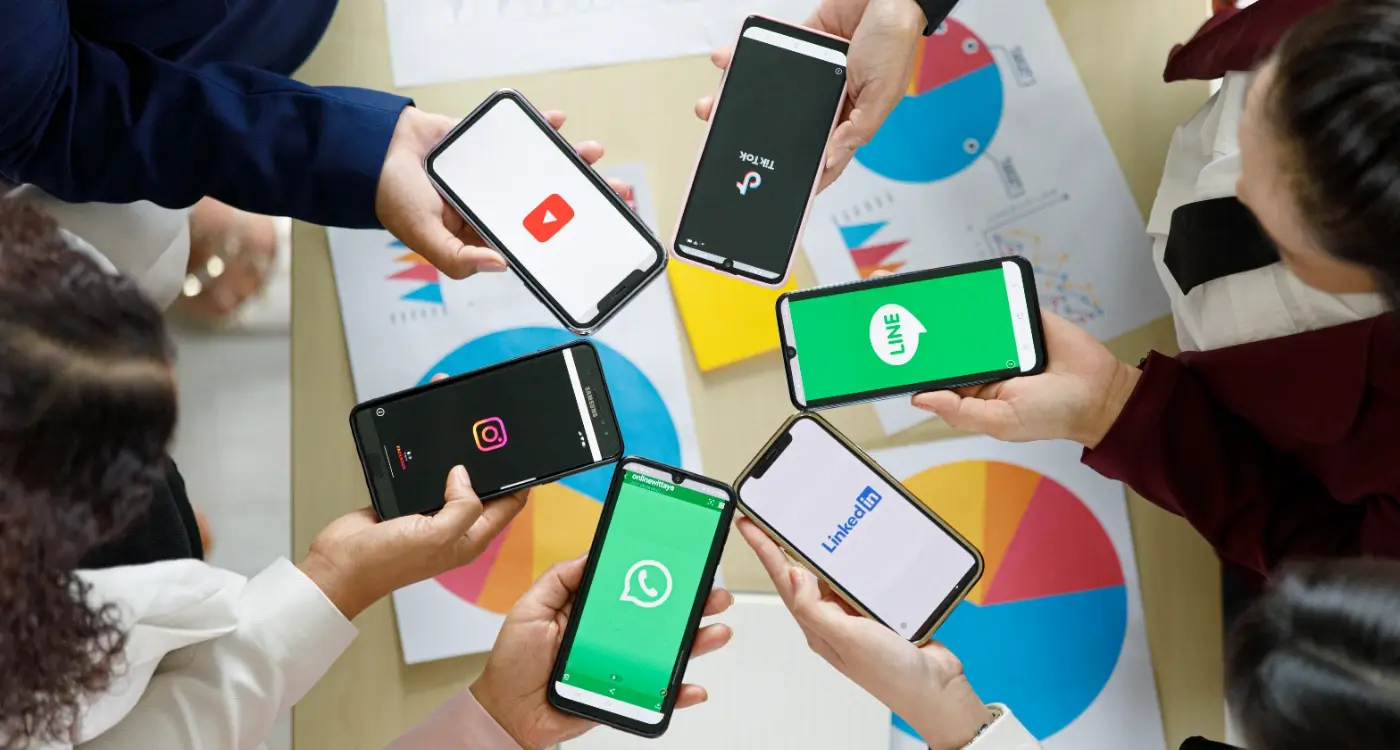How Much Does It Cost to Build a Social Media App Like Instagram?
Instagram generates over £70 billion in annual revenue, and behind that staggering figure lies one of the most sophisticated mobile applications ever built. When clients ask me about creating a social media app like Instagram, I can see the pound signs dancing in their eyes—but what they don't realise is the enormous investment required to make it happen. The cost to build an Instagram-like app isn't just about putting together a few screens where people can post photos; it's about creating a complex ecosystem that can handle millions of users, process billions of photos, and deliver content in real-time across the globe.
The truth is, there's no simple answer to the question "how much does it cost?" Building a social media app involves countless variables—from the features you want to include to the size of your development team. A basic version might cost £50,000, whilst a fully-featured platform could easily reach £500,000 or more. That's quite a range, isn't it?
The real challenge isn't just building the app—it's building an app that can scale from day one to handle the success you're hoping for
Throughout this guide, we'll break down every aspect of Instagram app development costs. From understanding the core features that make Instagram tick to examining the technical infrastructure that keeps it running smoothly, you'll get a clear picture of what building a social media app actually involves—and what it might cost you.
Understanding Instagram's Core Features and Functionality
Right, let's start with the basics—what actually makes Instagram tick? When you're thinking about building a social media app like Instagram, you need to understand what features make it work so well. It's not just about posting photos anymore; the platform has grown into something much more complex over the years.
The Foundation Features
Instagram started simple but now packs quite a punch. The core features that keep users coming back include photo and video sharing, stories that disappear after 24 hours, direct messaging, and the famous explore feed. Then there's IGTV for longer videos, Reels for short-form content, and shopping features that let brands sell directly through the app.
- Photo and video posting with filters and editing tools
- Stories with temporary content and interactive elements
- Direct messaging and group chats
- Explore page with personalised content discovery
- Reels for short-form video content
- Shopping integration and product tagging
- Live streaming capabilities
- Push notifications and activity feeds
The Technical Complexity Behind Simple Actions
Here's where it gets interesting from a development perspective. When someone double-taps to like a photo, that simple action triggers multiple backend processes—updating databases, sending notifications, adjusting algorithm signals, and syncing across devices. Each feature might seem straightforward to users, but building them requires sophisticated infrastructure that can handle millions of interactions simultaneously.
Breaking Down Development Costs by Feature Type
When clients ask me about Instagram app development costs, I always tell them the same thing—it's not about building one big app, it's about building dozens of smaller features that work together. Each feature comes with its own price tag, and understanding these individual costs helps you make smarter decisions about what to include in your minimum viable product.
Core Feature Pricing Structure
User registration and authentication might seem simple, but it typically costs between £3,000-£8,000 to build properly. Photo uploading and basic editing features will set you back £8,000-£15,000, whilst the camera integration with filters can easily reach £12,000-£20,000. The news feed—arguably Instagram's most complex feature—ranges from £15,000-£25,000 because of all the algorithms needed to display content intelligently.
| Feature Type | Development Cost Range | Complexity Level |
|---|---|---|
| User profiles and authentication | £3,000 - £8,000 | Medium |
| Photo upload and basic editing | £8,000 - £15,000 | High |
| Social features (likes, comments, follows) | £10,000 - £18,000 | High |
| Real-time messaging | £12,000 - £22,000 | Very High |
Advanced Features That Drive Costs Up
Stories functionality costs around £15,000-£30,000 because it requires temporary content storage and complex media handling. Real-time messaging systems are expensive—expect £12,000-£22,000 for basic chat functionality. Video features push costs even higher; basic video upload and playback starts at £20,000.
Start with core features like user profiles, photo sharing, and basic social interactions. You can always add expensive features like Stories and video later once you've validated your concept with users.
The Technical Infrastructure Behind Social Media Apps
Building a social media app like Instagram isn't just about pretty interfaces and smooth animations—there's a massive technical foundation that needs to be rock solid. I've seen apps fail due to performance issues where the backend infrastructure cost more than the entire frontend development; it's that complex.
Server Architecture and Database Management
Your app needs powerful servers to handle millions of users uploading photos, videos, and messages simultaneously. Think of it this way: every time someone posts a photo, that image needs to be stored, processed into different sizes, and delivered to potentially thousands of followers instantly. This requires distributed server systems across multiple locations, which can cost anywhere from £5,000 to £50,000 monthly depending on your user base.
Content Delivery and Storage Solutions
Photos and videos take up enormous amounts of storage space. Instagram stores billions of images—that's not cheap! You'll need cloud storage solutions like Amazon S3 or Google Cloud, plus content delivery networks to ensure your app loads quickly worldwide. For a new social app, expect to budget at least £2,000 monthly for storage and delivery services, scaling rapidly as you grow.
The real kicker? All this infrastructure needs to be built before you even know if people will use your app. It's a significant upfront investment that many founders underestimate.
Design and User Experience Investment Requirements
When people think about Instagram app development costs, they often focus on the coding side of things—but here's what many don't realise: the design and user experience work can make up 15-25% of your total project budget. That's a significant chunk, and for good reason.
Creating a social media app that people actually want to use requires serious thought about every screen, every button, every swipe. Users expect Instagram-level polish these days; they won't tolerate clunky interfaces or confusing navigation. This means investing in proper user research, wireframing, prototyping, and multiple rounds of design refinement.
The Core Design Investment Areas
Your design budget typically breaks down into user research (understanding what people actually want), visual design (making it look professional), and user experience design (making it work smoothly). Each of these areas requires different specialists with different skill sets—and different price points.
The best social media apps feel intuitive from the moment you open them, but that simplicity requires months of careful planning and testing
Why Cutting Design Costs Backfires
I've seen too many clients try to save money by rushing through the design phase or using generic templates. The result? Apps that look amateur and feel frustrating to use. Users delete these apps within minutes, making all that development work pointless. Investing properly in UX design upfront actually saves money by reducing the need for expensive redesigns later.
Development Team Structure and Associated Costs
Building a social media app like Instagram requires a well-structured development team, and getting this right can make or break your budget. I've seen projects go wildly over budget simply because clients didn't understand what roles they actually needed—and more importantly, when they needed them.
Your core team will need a project manager to keep everything on track, a UI/UX designer to create the visual elements, and developers who specialise in different areas. For iOS development you'll need Swift developers; for Android, you'll want Kotlin or Java specialists. Then there's the backend team who'll handle your servers, databases, and API development—these are the people who make sure your app can actually store photos and handle millions of users scrolling through their feeds.
Team Roles and Typical Costs
- Project Manager: £400-600 per day
- UI/UX Designer: £350-500 per day
- iOS Developer: £450-650 per day
- Android Developer: £450-650 per day
- Backend Developer: £500-700 per day
- QA Tester: £250-400 per day
These rates vary significantly based on location and experience level. A junior developer in Eastern Europe might cost £200-300 per day, while a senior developer in London could charge £800+ per day. The key is finding the right balance between cost and quality for your specific project needs.
Platform Considerations and Their Financial Impact
When I'm working with clients on Instagram-style app development, one of the biggest cost decisions they face is choosing between iOS, Android, or both platforms. This choice can literally double your development budget—or save you thousands if you make the right call early on.
Building for iOS first tends to be my recommendation for most social media apps. The development process is more streamlined, and iPhone users typically engage more with social platforms. Android development often takes 20-30% longer due to the sheer variety of devices and screen sizes you need to account for. That translates directly into higher development costs.
Platform-Specific Development Costs
| Platform | Development Time | Cost Range |
|---|---|---|
| iOS Only | 4-6 months | £40,000-£80,000 |
| Android Only | 5-7 months | £50,000-£95,000 |
| Both Platforms | 8-12 months | £80,000-£150,000 |
Cross-platform frameworks like React Native can reduce these costs by about 30%, but you'll sacrifice some performance and native features that make Instagram feel so smooth. For a social media app where user experience is everything, that trade-off isn't always worth it.
Start with one platform, validate your app idea, then expand to the second platform using your initial revenue. This approach reduces risk and spreads development costs over time.
Ongoing Maintenance and Post-Launch Expenses
Building your Instagram-like app is just the beginning—the real costs start after launch. I've seen too many clients get caught off guard by this reality, thinking their biggest expense was behind them once the app went live. The truth is, maintaining a social media app requires ongoing investment that can easily match or exceed your initial development costs.
Server and Infrastructure Costs
Your app will need hosting, and social media apps are particularly demanding on server resources. Photo and video storage costs alone can spiral quickly as your user base grows. Cloud services typically charge based on storage and bandwidth usage, which means your costs scale directly with success.
Development Team Retention
You'll need developers on standby for bug fixes, security updates, and new feature development. Most social media apps require monthly updates to stay competitive and secure. Operating system updates from Apple and Google also mean regular compatibility work.
Here's what you should budget for monthly:
- Server hosting and cloud storage (£500-£5,000+ depending on users)
- Developer retainer or part-time team (£2,000-£8,000)
- App store fees and payment processing (2-5% of revenue)
- Security monitoring and updates (£300-£1,000)
- Customer support tools and staff (£500-£2,000)
Smart planning means setting aside 15-20% of your initial development budget for monthly maintenance costs. This isn't optional—it's what keeps your app alive and competitive.
Conclusion
Building a social media app like Instagram isn't cheap—and anyone who tells you otherwise is probably trying to sell you something! From my experience working with clients over the years, I've seen budgets range from £50,000 for a basic MVP right up to £300,000+ for a fully-featured platform. The wide range depends on so many factors: your feature set, the development team you choose, whether you're building for iOS, Android, or both, and how much you're willing to invest in that polished user experience that makes apps feel premium.
What I always tell my clients is that the initial development cost is just the beginning. You'll need to budget for ongoing maintenance, server costs, security updates, and new feature development—these post-launch expenses can easily add up to 20-30% of your original development budget each year. The good news? You don't need to build everything at once. Starting with a solid MVP and gradually adding features based on user feedback is often the smartest approach, both financially and strategically.
The key is being realistic about your budget and timeline whilst not compromising on the core features that will make your app successful. Get those fundamentals right, and you'll have a strong foundation to build upon.
Share this
Subscribe To Our Learning Centre
You May Also Like
These Related Guides

How Much Does It Cost To Build A Dating App Like Bumble?

What Makes Messaging Apps So Expensive to Develop?



